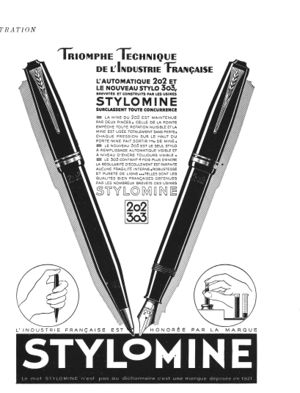Stylomine
Stylomine is one of the oldest French producers, which is highlighted in the fountain pen history for the unique filling system (which, by the shape of the sac, is called accordion filler) which distinguished his pens, that after the expiry of the relevant patent was adopted by many other French producers.
Although the produced models were few, the production company was still of high quality, and very interesting in the French market, in which the company was one of the most significant actors. The company has distinguished itself by technological innovation, having patent an hooded nib before the Parker 51 one, but like all historic French manufacturers could not withstand the impact of the advent of the ballpoint pen and disappeared from the market in the early 60s.
| Stylomine |
|---|
| Brand pages |
| Brand advertising |
| Brand photos |
| Instructions sheet |
| Patents |
History

An exact date for the founding of the company with the same name created by Yves E. Zuber it is not known[1] whose activities originate at the end of the first World War, with offices and factory in Paris on Rue Neuve des Boulet, 34-36 and in the Rue de Nice, 2 and later on Avenue Martin Moreau, 45 that was active on the market in the molding and assembly of metal parts, as bag hooks or clips and nibs for fountain pens.
The Stylomine brand was officially registered in 1921 with n. 199226, and was used by Yves E. Zuber for his pencils. The fountain pen production began only in 1925 with some safety models in black or red marbled black hard rubber. It was relevant also for the production of overlays in both rolled gold or precious metals. But in this period the product most characterizing the company's production is the mechanical pencil Autostyl, in which the mine is automatically replaced after exhaustion. The production of mechanical pencils will continue for all following years, with different names such as Stylomine Automatic and Stylomine 202.
Ma il modello di stilografica che ha reso famosa la Stylomine è la 303, introdotta nel 1930 e dotata di una serie di soluzioni tecniche molto peculiari, come un sistema di caricamento a pompetta molto funzionale e di grande capacità grazie ad uno sfiatatoio collegato ingegnosamente all'alimentatore (brevetto nº FR-712327), che consentiva il caricamento completo della penna con solo quattro o cinque pompate.
A questo modello venne aggiunto nel 1933 un particolarissimo gruppo pennino montato su una molla che veniva fatto rientrare con l'avvitamento del cappuccio grazie alla pressione di una punta interna (vedi brevetto nº FR-737930). Questo sistema, insieme al pennino rientrante, venne usato nel nuovo modello 303B, prodotto in tre versioni corrispondenti a tre diverse misure. Il caricamento era un perfezionamento del precedente sistema della 303 e venne usato anche per il modello 303C, senza pennino rientrante, che oltre alle tre versioni precedenti venne realizzato in celluloide e con una quarta dimensione, sufficientemente grande da farla denominare Mastodonte.
But the most significant feature of the new model, which will remain in all subsequent production of the company is the revolutionary system of accordion filler a peculiar variant of breather tube filler which allowed a large ink capacity, made well in advance of the American equivalents, and well before the success of the Parker Vacumatic. This system, along with the re-entrant nib, it was used by the 1933 in the new model 303B, produced in three versions, and the model 303B, without re-entrant nib, but that in addition to the three previous versions was also created in a size large enough to call it Mastodonte.
Particular interest come also from the development of the 303D, an hooded nib model, perhaps the first ever product, its patent (nº FR-850525) in fact is from 1938 and anticipates several months the corresponding (nº US-2223541) Parker patent that the company seems to have, once again, beaten to the punch in terms of innovation. In this case, however, we don't known exact dates for the appearance of the model on the market, which in some cases is reported as much later.[2]
Nel 1937 circa[3] venne lanciato il modello 303V (la data comunque è alquanto incerta), che adottava il caricamento a fisarmonica ed un nuovo stile svasato e l'uso di un corpo in materiale plastico (cosa che fa sospettare una apparizione più tarda).
Nel dopoguerra la produzione vide la diffusione della 303D a pennino coperto, affiancata da altri modelli come la Super 303 con pennino a punta rotonda. Venne mantenuto il caricamento a fisarmonica sostituendo il pulsante in vetro con uno in materiale plastico. Nel 1947 vennero introdotte le matite meccaniche Stylomine 404 e nel 1948 venne introdotta la penna a sfera Stylomine 707.
The company tried to respond to the crisis introduced by the advent of disposable spheres: the lever filler 505 model was introduced (now very rare), the company also joined to Météore, Paillard and Unic to produce the Pulsa Pen and formed a consortium with Bayard and Unic to create the BUC cartridge. It also introduced a cartridge model recovering the historical 303 name. But as with most other historic French manufacturers, the efforts were useless and the company ceased operations in the 60s.
Chronology
| Year | Event
External references
Notes
|
|---|